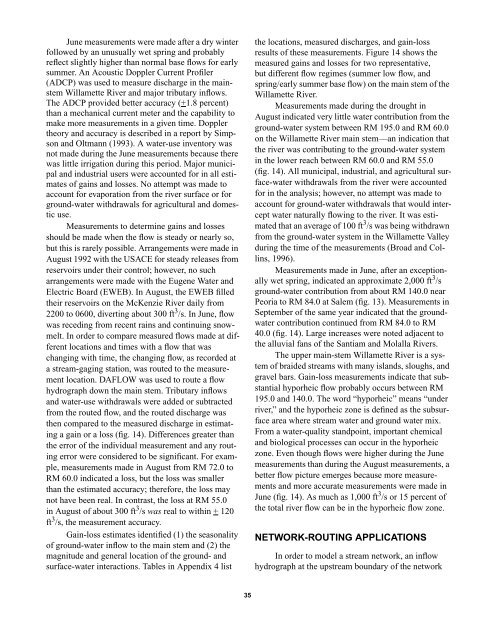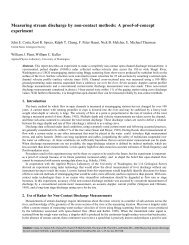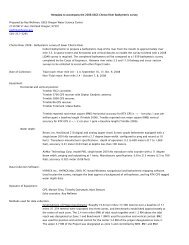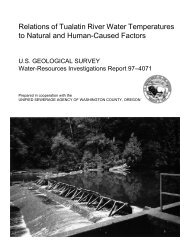samples were collected at various downstream locationsover a time interval (Hubbard <strong>and</strong> o<strong>the</strong>rs, 1982).Dye concentration was determined by measuring <strong>the</strong>fluorescence of <strong>the</strong> water samples. At each samplinglocation, a series of samples sufficient to define <strong>the</strong>passage of <strong>the</strong> dye cloud was collected. Stream dischargewas measured at <strong>the</strong> beginning <strong>and</strong> end of eachstudy reach <strong>and</strong> at all tributary inflows in order todefine total stream volume. Travel time of <strong>the</strong> dyecloud was determined by plotting <strong>the</strong> time-concentrationcurves <strong>and</strong> defining times <strong>for</strong> <strong>the</strong> leading edge,peak, trailing edge, <strong>and</strong> centroid of <strong>the</strong> individualcurves.Dye-tracer studies to determine stream time-oftravelwere conducted in <strong>the</strong> Willamette River <strong>and</strong>nine tributaries of <strong>the</strong> Willamette River from April1992 through July 1993 during low- to mediumstreamflowconditions. Results of <strong>the</strong>se studies arepresented in detail in a report by Lee (1995) <strong>for</strong> <strong>the</strong>main-stem Willamette River, Calapooia, South Yamhill,Yamhill, Molalla, Pudding, Tualatin, <strong>and</strong> ClackamasRivers, <strong>and</strong> Amazon, Mill, <strong>and</strong> Johnson Creeks.Locations of <strong>the</strong> various time-of-travel studies areshown in figure 13. An earlier report by Harris (1968)gives time-of-travel study results on <strong>the</strong> Middle, CoastFork, <strong>and</strong> main-stem Willamette Rivers, <strong>the</strong> Middle,South, North, <strong>and</strong> main-stem Santiam River, <strong>and</strong> <strong>the</strong>McKenzie River.Time-of-travel data were used to define <strong>the</strong> low<strong>and</strong>medium-flow range of area-discharge relationsrequired in <strong>the</strong> DAFLOW model. Results of <strong>the</strong>sestudies can also be used to define dispersion rates insolute-transport models. Time-of-travel studies areimportant in underst<strong>and</strong>ing low flows where pools <strong>and</strong>riffles control stream velocities. Channel conveyancecan be determined by a more conventional method—surveying stream cross-sections at selected intervals<strong>and</strong> estimating channel roughness (Manning’s “n”value). However, <strong>the</strong> process of model calibration atlow flows is tedious <strong>and</strong> inconclusive with this technique.The most accurate <strong>and</strong> cost-effective method tocalibrate <strong>the</strong> low-flow component of a routing modelwithin a given reach of channel is to measure <strong>the</strong> traveltime of a dye tracer.Gain-Loss InvestigationsGain-loss investigations are made to define <strong>the</strong>lateral inflow component used in streamflow-routingmodels; however, this in<strong>for</strong>mation has not yet beenfully utilized in <strong>the</strong> models presented in this report.Model algorithms that simulate <strong>the</strong> implied waterexchanges between <strong>the</strong> river <strong>and</strong> river gravels are notyet available. For water-quantity distribution, <strong>the</strong>sefluxes are not particularly important; however, whenwater-quality components are linked to <strong>the</strong> model,<strong>the</strong>ir importance will likely increase.Stream-discharge measurements to determinegains from <strong>and</strong> losses to ground water were made on<strong>the</strong> Willamette River <strong>and</strong> <strong>the</strong> Santiam River at low flowduring August 17–28, 1992, <strong>and</strong> at a snowmelt baseflow during June 21–30, 1993 (fig. 14). The Augustmeasurements on <strong>the</strong> Willamette River were madefrom RM 195.0 at <strong>the</strong> USGS stream-gagingstation at Jasper (14152000) to RM 55.0, just above <strong>the</strong>confluence of <strong>the</strong> Yamhill River <strong>and</strong> above NewbergPool. The August measurements on <strong>the</strong> Santiam Riverwere made from RM 28.5 at Stayton on <strong>the</strong> North SantiamRiver, <strong>and</strong> from RM 7.7 on <strong>the</strong> South SantiamRiver to RM 0.1 at <strong>the</strong> mouth of <strong>the</strong> Santiam River.The June measurements on <strong>the</strong> Willamette River weremade in <strong>the</strong> reach from RM 195.0 to RM 84.0 at <strong>the</strong>stream-gaging station at Salem, where <strong>the</strong>y were discontinueddue to equipment failure. The June measurementson <strong>the</strong> Santiam River were made from RM 9.6 at<strong>the</strong> stream-gaging station at Jefferson (14189000) toRM 0.1 at <strong>the</strong> mouth. The Willamette River from RM84.0 to RM 26.5 below <strong>the</strong> Tualatin River was measuredSeptember 21–22, 1993, to complete <strong>the</strong> reach ofriver that could not be measured in June because ofequipment failure.August measurements were made during a periodof drought, when small tributary inflows to <strong>the</strong> mainstem of <strong>the</strong> Willamette <strong>and</strong> Santiam Rivers werealmost nonexistent <strong>and</strong> water use was high. Measurementswere made with Price AA <strong>and</strong> pygmy mechanicalcurrent meters using techniques as described byRantz (1982). To obtain accuracies within +3 percent,more measurements of point velocities (30–60 pointvelocities were measured ra<strong>the</strong>r than <strong>the</strong> 20–30 pointsnormally measured when making conventional dischargecomputations) <strong>and</strong> more measurements of waterdepth were made <strong>for</strong> each separate computation of discharge.As part of <strong>the</strong> August measurements, a wateruseinventory was conducted on <strong>the</strong> main stem of <strong>the</strong>Willamette <strong>and</strong> Santiam Rivers on <strong>the</strong> same reaches ofriver. The water-use inventory was intended as a synopticmeasurement that would identify relative contributions.No attempt was made to account <strong>for</strong>evaporation from <strong>the</strong> river surface or <strong>for</strong> ground-waterwithdrawals <strong>for</strong> agricultural <strong>and</strong> domestic use.34
June measurements were made after a dry winterfollowed by an unusually wet spring <strong>and</strong> probablyreflect slightly higher than normal base flows <strong>for</strong> earlysummer. An Acoustic Doppler Current Profiler(ADCP) was used to measure discharge in <strong>the</strong> mainstemWillamette River <strong>and</strong> major tributary inflows.The ADCP provided better accuracy (+1.8 percent)than a mechanical current meter <strong>and</strong> <strong>the</strong> capability tomake more measurements in a given time. Doppler<strong>the</strong>ory <strong>and</strong> accuracy is described in a report by Simpson<strong>and</strong> Oltmann (1993). A water-use inventory wasnot made during <strong>the</strong> June measurements because <strong>the</strong>rewas little irrigation during this period. Major municipal<strong>and</strong> industrial users were accounted <strong>for</strong> in all estimatesof gains <strong>and</strong> losses. No attempt was made toaccount <strong>for</strong> evaporation from <strong>the</strong> river surface or <strong>for</strong>ground-water withdrawals <strong>for</strong> agricultural <strong>and</strong> domesticuse.Measurements to determine gains <strong>and</strong> lossesshould be made when <strong>the</strong> flow is steady or nearly so,but this is rarely possible. Arrangements were made inAugust 1992 with <strong>the</strong> USACE <strong>for</strong> steady releases fromreservoirs under <strong>the</strong>ir control; however, no sucharrangements were made with <strong>the</strong> Eugene Water <strong>and</strong>Electric Board (EWEB). In August, <strong>the</strong> EWEB filled<strong>the</strong>ir reservoirs on <strong>the</strong> McKenzie River daily from2200 to 0600, diverting about 300 ft 3 /s. In June, flowwas receding from recent rains <strong>and</strong> continuing snowmelt.In order to compare measured flows made at differentlocations <strong>and</strong> times with a flow that waschanging with time, <strong>the</strong> changing flow, as recorded ata stream-gaging station, was routed to <strong>the</strong> measurementlocation. DAFLOW was used to route a flowhydrograph down <strong>the</strong> main stem. Tributary inflows<strong>and</strong> water-use withdrawals were added or subtractedfrom <strong>the</strong> routed flow, <strong>and</strong> <strong>the</strong> routed discharge was<strong>the</strong>n compared to <strong>the</strong> measured discharge in estimatinga gain or a loss (fig. 14). Differences greater than<strong>the</strong> error of <strong>the</strong> individual measurement <strong>and</strong> any routingerror were considered to be significant. For example,measurements made in August from RM 72.0 toRM 60.0 indicated a loss, but <strong>the</strong> loss was smallerthan <strong>the</strong> estimated accuracy; <strong>the</strong>re<strong>for</strong>e, <strong>the</strong> loss maynot have been real. In contrast, <strong>the</strong> loss at RM 55.0in August of about 300 ft 3 /s was real to within + 120ft 3 /s, <strong>the</strong> measurement accuracy.Gain-loss estimates identified (1) <strong>the</strong> seasonalityof ground-water inflow to <strong>the</strong> main stem <strong>and</strong> (2) <strong>the</strong>magnitude <strong>and</strong> general location of <strong>the</strong> ground- <strong>and</strong>surface-water interactions. Tables in Appendix 4 list<strong>the</strong> locations, measured discharges, <strong>and</strong> gain-lossresults of <strong>the</strong>se measurements. Figure 14 shows <strong>the</strong>measured gains <strong>and</strong> losses <strong>for</strong> two representative,but different flow regimes (summer low flow, <strong>and</strong>spring/early summer base flow) on <strong>the</strong> main stem of <strong>the</strong>Willamette River.Measurements made during <strong>the</strong> drought inAugust indicated very little water contribution from <strong>the</strong>ground-water system between RM 195.0 <strong>and</strong> RM 60.0on <strong>the</strong> Willamette River main stem—an indication that<strong>the</strong> river was contributing to <strong>the</strong> ground-water systemin <strong>the</strong> lower reach between RM 60.0 <strong>and</strong> RM 55.0(fig. 14). All municipal, industrial, <strong>and</strong> agricultural surface-waterwithdrawals from <strong>the</strong> river were accounted<strong>for</strong> in <strong>the</strong> analysis; however, no attempt was made toaccount <strong>for</strong> ground-water withdrawals that would interceptwater naturally flowing to <strong>the</strong> river. It was estimatedthat an average of 100 ft 3 /s was being withdrawnfrom <strong>the</strong> ground-water system in <strong>the</strong> Willamette Valleyduring <strong>the</strong> time of <strong>the</strong> measurements (Broad <strong>and</strong> Collins,1996).Measurements made in June, after an exceptionallywet spring, indicated an approximate 2,000 ft 3 /sground-water contribution from about RM 140.0 nearPeoria to RM 84.0 at Salem (fig. 13). Measurements inSeptember of <strong>the</strong> same year indicated that <strong>the</strong> groundwatercontribution continued from RM 84.0 to RM40.0 (fig. 14). Large increases were noted adjacent to<strong>the</strong> alluvial fans of <strong>the</strong> Santiam <strong>and</strong> Molalla Rivers.The upper main-stem Willamette River is a systemof braided streams with many isl<strong>and</strong>s, sloughs, <strong>and</strong>gravel bars. Gain-loss measurements indicate that substantialhyporheic flow probably occurs between RM195.0 <strong>and</strong> 140.0. The word “hyporheic” means “underriver,” <strong>and</strong> <strong>the</strong> hyporheic zone is defined as <strong>the</strong> subsurfacearea where stream water <strong>and</strong> ground water mix.From a water-quality st<strong>and</strong>point, important chemical<strong>and</strong> biological processes can occur in <strong>the</strong> hyporheiczone. Even though flows were higher during <strong>the</strong> Junemeasurements than during <strong>the</strong> August measurements, abetter flow picture emerges because more measurements<strong>and</strong> more accurate measurements were made inJune (fig. 14). As much as 1,000 ft 3 /s or 15 percent of<strong>the</strong> total river flow can be in <strong>the</strong> hyporheic flow zone.NETWORK-ROUTING APPLICATIONSIn order to model a stream network, an inflowhydrograph at <strong>the</strong> upstream boundary of <strong>the</strong> network35
- Page 1: Precipitation-Runoff and Streamflow
- Page 4 and 5: U.S. DEPARTMENT OF THE INTERIORBRUC
- Page 6 and 7: Determining Travel Time and Dilutio
- Page 8 and 9: 2. Stream-gaging stations used to c
- Page 10 and 11: Page Intentionally Blank
- Page 12 and 13: network-routing models where availa
- Page 14 and 15: made on the main stem at base-flow
- Page 16 and 17: Figure 1. Willamette River Basin, O
- Page 18 and 19: EvapotranspirationINPUTSAirtemperat
- Page 20 and 21: Table 1. Climate stations used to c
- Page 22 and 23: Table 2. Stream-gaging stations use
- Page 24 and 25: Figure 4. Mean annual precipitation
- Page 26 and 27: Major Land Use MapHydrologic Soil G
- Page 28 and 29: 0.5 mi 2 , created in the merge of
- Page 30 and 31: Table 6. Geology and soils matrix o
- Page 32 and 33: tion value of the HRU class by the
- Page 34 and 35: Table 8. Selected monthly basinwide
- Page 36 and 37: Figure 9. Location of Precipitation
- Page 38 and 39: Table 11. Statistical analyses of P
- Page 40 and 41: flow can become a significant compo
- Page 42 and 43: diffusion at selected grid interval
- Page 46 and 47: 3,0002,500June 21-30, 1993September
- Page 48 and 49: stream network is shown on figure 1
- Page 50 and 51: 122˚30´ 15´122˚00´121˚45´Roc
- Page 52 and 53: 123˚22´30´´ 123˚15´ 123˚00´
- Page 54 and 55: 123˚00´´ 45´30´122˚15´45˚15
- Page 56 and 57: YamhillRiver123˚45´ 30´ 15´123
- Page 58 and 59: 123˚07´30´´ 123˚00´ 45´ 30´
- Page 60 and 61: 123˚07´30´´ 123˚00´ 45´ 30´
- Page 62 and 63: 44˚15´14166000122˚07´30´´Will
- Page 64 and 65: 122˚15´ 122˚00´121˚52´30´´4
- Page 66 and 67: 44˚52´30´´45´122˚15´ 122˚00
- Page 68 and 69: observed flow at the Willamette Riv
- Page 70 and 71: DAFLOW model, and peak amplitude is
- Page 72 and 73: 20DYE CONCENTRATION, IN MICROGRAMS
- Page 74 and 75: ARC-INFO and Geographic Information
- Page 76 and 77: WILL.WDMData-base file(Observed pre
- Page 78 and 79: WILL.WDMData-base fileSWSTATSFreque
- Page 80 and 81: Jobson, H.E., 1980, Comment on A ne
- Page 82 and 83: Page Intentionally Blank
- Page 84 and 85: APPENDIX 1. STREAM GEOMETRY FOR MAI
- Page 86 and 87: APPENDIX 1. STREAM GEOMETRY FOR MAI
- Page 88 and 89: APPENDIX 1. STREAM GEOMETRY FOR MAI
- Page 90 and 91: APPENDIX 1. STREAM GEOMETRY FOR MAI
- Page 92 and 93: APPENDIX 1. STREAM GEOMETRY FOR MAI
- Page 94 and 95:
APPENDIX 1. STREAM GEOMETRY FOR MAI
- Page 96 and 97:
APPENDIX 1. STREAM GEOMETRY FOR MAI
- Page 98 and 99:
APPENDIX 1. STREAM GEOMETRY FOR MAI
- Page 100 and 101:
APPENDIX 1. STREAM GEOMETRY FOR MAI
- Page 102 and 103:
APPENDIX 1. STREAM GEOMETRY FOR MAI
- Page 104 and 105:
APPENDIX 1. STREAM GEOMETRY FOR MAI
- Page 106 and 107:
APPENDIX 1. STREAM GEOMETRY FOR MAI
- Page 108 and 109:
APPENDIX 1. STREAM GEOMETRY FOR MAI
- Page 110 and 111:
APPENDIX 2. ARC MACRO LANGUAGE (AML
- Page 112 and 113:
APPENDIX 2. ARC MACRO LANGUAGE (AML
- Page 114 and 115:
APPENDIX 2. ARC MACRO LANGUAGE (AML
- Page 116 and 117:
APPENDIX 2. ARC MACRO LANGUAGE (AML
- Page 118 and 119:
APPENDIX 2. ARC MACRO LANGUAGE (AML
- Page 120 and 121:
APPENDIX 2. ARC MACRO LANGUAGE (AML
- Page 122 and 123:
APPENDIX 3. DEFINITIONS OF PARAMETE
- Page 124 and 125:
APPENDIX 3. DEFINITIONS OF PARAMETE
- Page 126 and 127:
APPENDIX 4. MEASUREMENTS USED TO DE
- Page 128 and 129:
APPENDIX 4. MEASUREMENTS USED TO DE
- Page 130 and 131:
APPENDIX 4. MEASUREMENTS USED TO DE
- Page 132 and 133:
APPENDIX 4. MEASUREMENTS USED TO DE
- Page 134 and 135:
APPENDIX 5. EXAMPLE PRECIPITATION-R
- Page 136 and 137:
APPENDIX 5. EXAMPLE PRECIPITATION-R
- Page 138 and 139:
APPENDIX 6. DIFFUSION ANALOGY FLOW
- Page 140 and 141:
APPENDIX 6. DIFFUSION ANALOGY FLOW
- Page 142 and 143:
APPENDIX 6. DIFFUSION ANALOGY FLOW
- Page 144 and 145:
APPENDIX 6. DIFFUSION ANALOGY FLOW
- Page 146 and 147:
APPENDIX 6. DIFFUSION ANALOGY FLOW
- Page 148 and 149:
APPENDIX 6. DIFFUSION ANALOGY FLOW
- Page 150 and 151:
APPENDIX 7. PROGRAMMING STEPS TO IN
- Page 152 and 153:
APPENDIX 8. PROGRAMMING STEPS TO DE
- Page 154 and 155:
APPENDIX 8. PROGRAMMING STEPS TO DE
- Page 156 and 157:
APPENDIX 8. PROGRAMMING STEPS TO DE
- Page 158 and 159:
APPENDIX 8. PROGRAMMING STEPS TO DE
- Page 160 and 161:
150Climatemaxtempmintempprecipitati
- Page 162 and 163:
APPENDIX 10. DIRECTORY TREE AND DES
- Page 164 and 165:
APPENDIX 10. DIRECTORY TREE AND DES
- Page 166 and 167:
APPENDIX 10. DIRECTORY TREE AND DES
- Page 168 and 169:
APPENDIX 10. DIRECTORY TREE AND DES
- Page 170 and 171:
APPENDIX 10. DIRECTORY TREE AND DES
- Page 172 and 173:
APPENDIX 10. DIRECTORY TREE AND DES
- Page 174 and 175:
APPENDIX 10. DIRECTORY TREE AND DES
- Page 176 and 177:
APPENDIX 10. DIRECTORY TREE AND DES
- Page 178 and 179:
APPENDIX 10. DIRECTORY TREE AND DES
- Page 180 and 181:
APPENDIX 11. DIRECTORY TREES AND DE
- Page 182 and 183:
APPENDIX 11. DIRECTORY TREES AND DE
- Page 184 and 185:
APPENDIX 12. DIRECTORY FOR will.wdm
- Page 186 and 187:
APPENDIX 12. DIRECTORY FOR will.wdm
- Page 188 and 189:
APPENDIX 12. DIRECTORY FOR will.wdm
- Page 190 and 191:
APPENDIX 12. DIRECTORY FOR will.wdm
- Page 192 and 193:
APPENDIX 12. DIRECTORY FOR will.wdm
- Page 194 and 195:
APPENDIX 12. DIRECTORY FOR will.wdm
- Page 196 and 197:
APPENDIX 13. PROGRAMMING STEPS FOR
- Page 198 and 199:
APPENDIX 13. PROGRAMMING STEPS FOR
- Page 200 and 201:
APPENDIX 13. PROGRAMMING STEPS FOR
- Page 202 and 203:
APPENDIX 14. INPUT FILES FOR BRANCH
- Page 204 and 205:
APPENDIX 14. INPUT FILES FOR BRANCH
- Page 206 and 207:
APPENDIX 14. INPUT FILES FOR BRANCH







